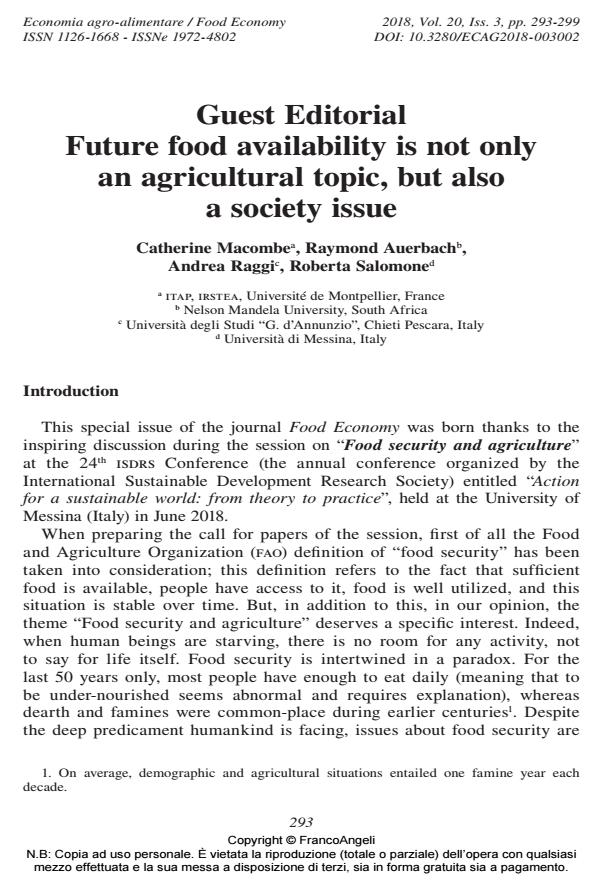Guest Editorial Future food availability is not only an agricultural topic, but also a society issue
Titolo Rivista ECONOMIA AGRO-ALIMENTARE
Autori/Curatori Catherine Macombe, Raymond Auerbach, Andrea Raggi, Roberta Salomone
Anno di pubblicazione 2019 Fascicolo 2018/3
Lingua Inglese Numero pagine 7 P. 293-299 Dimensione file 83 KB
DOI 10.3280/ECAG2018-003002
Il DOI è il codice a barre della proprietà intellettuale: per saperne di più
clicca qui
Qui sotto puoi vedere in anteprima la prima pagina di questo articolo.
Se questo articolo ti interessa, lo puoi acquistare (e scaricare in formato pdf) seguendo le facili indicazioni per acquistare il download credit. Acquista Download Credits per scaricare questo Articolo in formato PDF

FrancoAngeli è membro della Publishers International Linking Association, Inc (PILA)associazione indipendente e non profit per facilitare (attraverso i servizi tecnologici implementati da CrossRef.org) l’accesso degli studiosi ai contenuti digitali nelle pubblicazioni professionali e scientifiche
- Agreste Primeur (2008) Les rendements du ble et du mais ne progressent plus, Agreste: la statistique agricole n. 210, May 2008, Service central des enquetes et etudes statistiques.
- Auerbach, R. (2018a). Sustainable food systems for Africa. Economia Agro-Alimentare/Food Economy, 20(3), 299-318. DOI: 10.3280/ECAG2018-003003
- Auerbach, R. (2018b). Organic research and government support improve organic policy and progress in Danish, Swiss, American and African case studies. Economia Agro-Alimentare/Food Economy, 20(3), 331-347. DOI: 10.3280/ECAG2018-003005
- Calzadilla, A., Rehdanz, K., Betts, R., Falloon P., Wiltshire, A., & Tol, R.S.J. (2013). Climate change impacts on global agriculture. Climatic Change 120, 357.
- Drawdown project -- www.drawdown.org/scenarios (accessed the 26th of June 2018).
- Candy, S., Turner, G.M., Sheridan, J. & Carey, R. (2018). Quantifying Melbourne’s “Foodprint”: a scenario modelling methodology to determine the environmental impact of feeding a city. Economia Agro-Alimentare/Food Economy, 20(3), 369-397. DOI: 10.3280/ECAG2018-003007
- fao (2000). World agriculture: towards 2015/2030. -- Available at www.fao.org/docrep/004/y3557f/y3557f08.htm.
- fao (2017a). The state of food security and nutrition in the World. Annual flagship report jointly prepared by fao, ifad, unicef, wfp and who. September 2017, Rome: fao.
- fao (2017b). The future of food and agriculture – Trends and challenges. Roma: fao. ISBN 978-92-5-109551-5.
- ipcc (2007). Climate Change 2007: The Physical Science Basis. Contribution of Working Group I to the Fourth Assessment. Report of the Intergovernmental Panel on Climate Change. Solomon, S., Qin, D., Manning, M., Chen, Z., Marquis,
- M., Averyt, K.B., Tignor, M. & Miller, H.L. (Eds.). Cambridge University Press, Cambridge, United Kingdom and New York, NY, usa, 996 pp.
- Le Mouel, C., Forslund, A., Marty, P., Manceron, S., Marajo-Petitzon, E., Caillaud, M.A., & Schmitt, B. (2017). La dépendance alimentaire de l’Afrique du Nord et du Moyen-Orient à l’horizon 2050. Versailles: Editions Qu..
- Le Mouel, C., & Forslund, A. (2017). How can we feed the world in 2050? A review of the responses from global scenario studies. European review of Agricultural Economics, 44(4), 541-591.
- Loeillet, D. (2018). Ignorance is bliss, but toxic to agriculture. Economia Agro-Alimentare/Food Economy, 20(3), 319-329. DOI: 10.3280/ECAG2018-003004
- Macombe, C. (2018). Diversity of food systems for securing future food availability. Economia Agro-Alimentare/Food Economy, 20(3), 349-368. DOI: 10.3280/ECAG2018-003006
- Meadows, D.H., Meadows, D.L., Randers, J., & Behrens, W.W. III (1972). The limits to growth: a report for the Club of Rome’s project on the predicament of mankind. New York: Universe book.
- Norris, C.E., & Congreves, K.A. (2018). Alternative Management practices improve soil health indices in intensive vegetable cropping systems: a review. Frontiers in Environmental Science 6, 50.
- Paganini, N., Lemke, S., & Raimundo, I. (2018). The potential of urban agriculture towards a more sustainable urban food system in food-insecure neighbourhoods in Cape Town and Maputo. Economia Agro-Alimentare/Food Economy, 20(3), 399-421. DOI: 10.3280/ECAG2018-003008
- Shift Project -- http://decarbonizeurope.org/wp-content/uploads/2016/11/9-Alimentationversion-longue.pdf (accessed the 26th June 2018).
- Terrones Gavira, F., & Burny, P. (2012). Évolution du marché mondial du blé au cours des cinquante dernières années. Livre Blanc «Céréales» ULg Gembloux Agro-Bio Tech et CRA-W Gembloux – Février 2012. -- Available at: www.gembloux.ulg.ac.be/phytotechnie-temperee/LIVREBLANC/LBfev2012/fichiers/9.%20Economie%20LB%202012%20sec.pdf.
- Turner, G. (2014). Is Global Collapse Imminent?, MSSI Research Paper No. 4, Melbourne Sustainable Society Institute, The University of Melbourne. ISBN: 9780 7340 4940 7.
- Westhoek, H., Rood, T., van den Berg, M., Janse, J., Nijdam, D., Reudink, M., & Stehfest, E. (2011). The Protein Puzzle. The Hague: PBL Netherlands Environmental Assessment Agency.
Catherine Macombe, Raymond Auerbach, Andrea Raggi, Roberta Salomone, Guest Editorial Future food availability is not only an agricultural topic, but also a society issue in "ECONOMIA AGRO-ALIMENTARE" 3/2018, pp 293-299, DOI: 10.3280/ECAG2018-003002